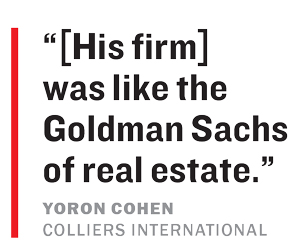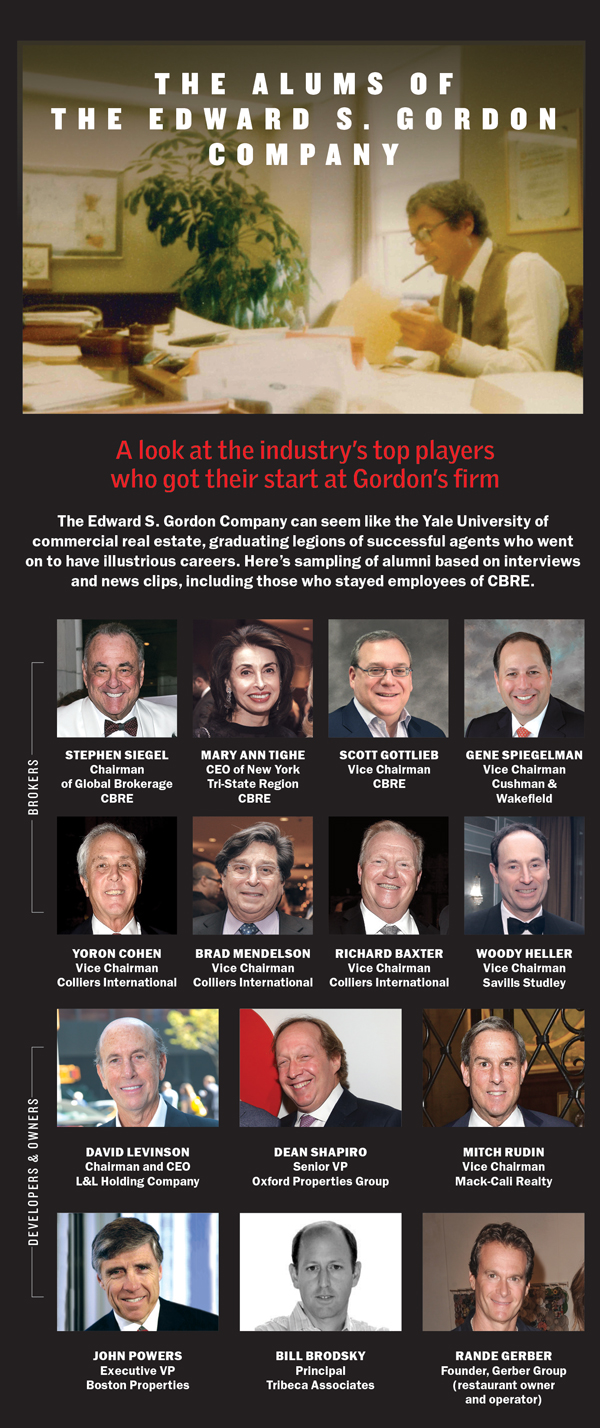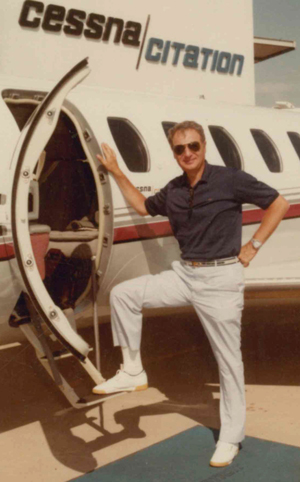From the March issue: Agents with specialties. Electronic databases that track tenants. Shiny shoes and suspenders.
In ways both substantive and superficial, the Edward S. Gordon Company, a firm that came to prominence in New York in the 1980s, was instrumental in creating the modern-day commercial-brokerage business.
A clear line can be drawn from that legacy to the firm’s namesake: a colorful character who generated tremendous good will before his death at the age of 65 in 2000, according to former colleagues, who populate the upper ranks (see sidebar) of real estate today.
“He had a great street sense, he understood people, and he was an incredible salesman,” said Stephen Siegel, CBRE’s chairman of global brokerage, who worked at Gordon’s company from 1992 until it merged with CBRE in 2003.
“Most people would turn and leave after someone said, ‘No, thank you,’” added Siegel, who eulogized Gordon at his funeral. But Gordon, he said, would persist until that person finally came around.
Over the years, Gordon’s firm amassed major clients including Sony, Chase Bank, Viacom, Donald Trump and the New York Times. And Gordon himself was known for turning around the Chrysler Building and other major Manhattan office towers.
He imposed his own style and flair on the business while introducing rules that are ingrained in the industry today, such as working in teams and dressing to the nines, according to several of the industry players who worked closely with him.
“He was god,” commercial real estate broker Yoron Cohen said of Gordon, whose photo still hangs on walls of alums of Gordon’s firm. Cohen, now a vice president in Colliers International’s investment sales division, first joined Gordon’s firm in 1988 from what was then Newmark and Company but was let go two years later during the depths of the recession.
Gordon eventually brought him back on, a year later, and he worked there until the merger with CBRE.
“When you would see him in the elevator in the morning, he would say, ‘Did you make any money for us today?’” Cohen recalled.
Brooklyn bred
Gordon was raised in Midwood, Brooklyn. His parents, Laura and Ben, sold novelty items like joy buzzers and pens with photos of women whose bathing suits would vanish when tipped in a certain direction, said Robin Gordon, one of the late broker’s daughters. As a teenager, Gordon helped his father with the business, but his mother told him that despite their comfortable upper-middle-class background, gag gifts shouldn’t be his future.
“She told him, ‘You can do better than this,’” Robin said.

Gordon, who struggled with dyslexia all of his life, wasn’t enamored with school, though he still made it through college, at Temple University in Philadelphia, where he majored in business, Robin said. After graduating, he enlisted in the Army Reserve and was stationed in Virginia, Robin said. (Gordon took advantage of the reserve’s free flying lessons. Later in his career he was known for buying planes, and on certain occasions flew as far as England solo.)
During his time in the Army he met Lou Brause, the son of Jack Brause and scion of a family that for decades had developed office buildings in New York. In the mid-1960s, after Gordon returned to the Big Apple and began a career as a real estate broker, that connection came in handy.
Gordon, at the time working for a major office leasing firm called Huberth and Huberth, did several deals with Lou and his father, including the purchase of 45 West 34th Street, a Beaux-Arts office building, according to news reports.
During those years, brokers operated very differently from today’s agents.
“A lot of times the agents were also the building supers,” said Brad Mendelson, a vice chairman of Colliers who worked at Gordon’s firm from 1978 to 2004.
They would typically work alone, and about all it would take for an agent to get a deal done was to meet a potential tenant over cocktails and scribble some lease terms on a napkin, according to brokers who worked in that era.
It wasn’t until roughly a decade later that Gordon would change that.
“He figured out a way to run the business like it had never been run before,” said Robert Baraf, an executive director with Cushman & Wakefield who joined the Edward S. Gordon Company in 1986 and stayed until 2003.
Reinventing the broker
Before the Edward S. Gordon Company came along, a single broker was often in charge of a commercial building, responsible for leasing out its upstairs office space as well any ground-floor retail.
Gordon, who founded his firm in 1972, thought agents should be more specialized by deal type and created about a half dozen of them — retail, building sales, office leasing, building management, industrial leasing and consulting departments, former employees said.
 “When I joined, it was like, ‘Whatever buildings you’ve got, I’ll handle the retail,’ and it worked well,” Mendelson said.
“When I joined, it was like, ‘Whatever buildings you’ve got, I’ll handle the retail,’ and it worked well,” Mendelson said.
Gordon also standardized the process for keeping tabs on who was leasing where, Baraf said. After spending hours canvassing buildings — riding elevators up and down and identifying tenants and available spaces — agents were expected to head back to the office and enter the data into a computer so the whole office could access it.
Gordon was a believer in teams “as opposed to whoever got the call,” Baraf said.
Among those teams was a group of consultants — many equipped with law and business degrees in an industry where such qualifications were scarce — that could drill down into the economics of one lease versus another in an attempt to close a deal.
“The secret sauce was the consulting group,” said Dean Shapiro, who joined in 1989 upon graduating from Cornell’s business school.
Gordon and Martin Turchin, a 1985 hire who retired from CBRE 13 years later, dreamed up the idea to have consultants expand upon “the skill set of the traditional broker, which is about market knowledge and negotiation,” Shaprio explained.
“That allowed them to compete more effectively,” said Shapiro, now a senior vice president with global real estate owner Oxford Properties Group.
Several industry players said that most of the other major commercial brokers have added consultants since then. With all the talent Gordon assembled, the Edward S. Gordon Company “was like the Goldman Sachs of real estate,” Cohen noted.
Button-down culture
Gordon’s firm bounced around Manhattan. Its first location was on West 39th Street, and the firm later moved to 415 Madison Avenue before landing in 1980 at the Chrysler Building.
(All of the Edward S. Gordon Company’s offices included the 18th floor, according to former employees, since 18 is considered a special number in Judaism.)
The Art Deco Chrysler had been deteriorating and was largely unoccupied before the Massachusetts Mutual Life Insurance Company — which took possession of the property in a foreclosure — spent $23 million on a top-to-bottom refurbishing in the late 1970s. The insurance firm hired Gordon to trumpet that turnaround.

Gordon and his Cessna Citation 4 airplane
Gordon devised a three-day marketing campaign in the New York Times in which mysterious full-page pen-and-ink drawings of the tower ran on consecutive days.
On the first day, a drawing of the tower’s gleaming spire was shown without any words on the page. On the second day, the ad showed a drawing of the spire plus the middle of the building — also without copy. And on the final day, the ad showed the entirety of the tower, along with an announcement that Gordon’s firm had been named the building’s exclusive leasing agent.
Another of his big-league deals was the rescue of 1166 Avenue of the Americas, a chronically vacant money pit that had bled $110 million since its construction in 1970, according to news reports. In 1978, a team of brokers that included Gordon split the building into a pair of commercial condos — a rare move at the time — and sold them to the New York Telephone Company and the Teachers Insurance and Annuity Association of America.
Gordon’s firm moved to the MetLife Building at 200 Park Avenue in 1987. Its office was sophisticated by industry standards, agents said — more like a law firm than a place for marketing properties. It spread across two floors and had ample fax machines, a luxury at the time, as well as a lounge where brokers were expected to get to know one another, Cohen said.
At all those offices, Gordon insisted on neat grooming, according to those who worked for him. White shirts, dark suits and lace-up shoes were a must; he also preferred men wear suspenders, according to Mendelson, who recalled that Gordon himself seemed to have “hundreds” of pairs.
Another rule: Employees should never peruse newspapers at their desks. “They should have read them before they got to the office,” Mendelson said.
Gordon, for his part, was quirky. While he held himself and his employees to high standards, those rules didn’t apply to all aspects of his life. Family members recall him heading for the kids’ table at bar mitzvahs, where he knew he could find hot dogs.
Gordon, who rarely drank, wasn’t one for fine dining. Before the Edward S. Gordon Company was founded, Siegel, then at Cushman and Wakefield, would have monthly meetings with Gordon at the Second Avenue Deli.
There, in the East Village, where few people knew them, they could freely dish about the industry over celery and cream sodas. At other restaurants, Gordon would squeeze ketchup on spaghetti, Siegel recalled.
Occasionally, Gordon would meet clients at David K’s, an upscale Chinese restaurant at Third Avenue and East 65th Street, according to Siegel. But even at that white-tablecloth joint, he added, Gordon’s germophobe tendencies came out: He demanded that waiters bring sodas with their caps still on so Gordon could open the bottles himself.
However, Siegel noted, “he would also buy roasted nuts from sidewalk vendors that had been sitting outside all day.”
Up, up and away
Gordon did well for himself. Even before his firm significantly expanded, a 1978 Times article referred to him as the “head of one of the city’s most aggressive and successful real estate firms.”
He lived for years in a brownstone he owned on the Upper West Side, near Riverside Drive, followed by 860 Park Avenue, a prewar co-op, among other uptown apartments. In the 1990s, Gordon built a country retreat for himself called Three Ponds. The windswept 60-acre spread in Bridgehampton, Long Island, sits across from the Atlantic Golf Club, which he also helped develop.
The estate, which included its own nine-green golf course designed by Robert Trent Jones Jr., was listed in 2003 by Cheryl Gordon Krongard, Edward’s third wife, for $75 million. In 2015, the price was slashed to $50 million. It’s still on the market.
Through the years, Gordon also invested in buildings on his own, such as 441 Lexington Avenue, a 19-story prewar tower at East 44th Street, across from Grand Central.
Yet to avoid the appearance of self-dealing, Gordon took pains to not promote his own properties to his firm’s office-seeking clients, colleagues say.
“We really had a straight-shooting operation,” said Anthony Saytanides, an attorney who worked at Gordon’s firm from 1984 to 1997 and served as chief operating officer. “He was very honorable.”
Another lucrative side project, colleagues said, was an investment in Meyers Brothers Parking System, a garage and parking-lot chain in New York and elsewhere. Working with entrepreneur Leo Fink, Gordon snapped up shares in the company before assuming control and taking it private. Some Meyers parking sites were later redeveloped. Edward’s brother, Allan, was involved in that business line, according to family members.
When New York’s fortunes turned around in the 1980s, the Edward S. Gordon Company mushroomed, adding hundreds of employees. But in 1996, when the Insignia Financial Group snapped up the firm for $74 million, retooling it as Insignia/ESG Holdings in the process, the growth sharply accelerated, as the firm expanded nationally and swelled with a payroll of thousands.
A soft side
When not taking swings in the Hamptons, Gordon liked to fly planes, which he kept at Teterboro Airport in New Jersey, Robin said.
In 1981, he flew solo across the Atlantic to England, where he hired a band to greet him with “The Stars and Stripes Forever,” Siegel said. “He was one of the great characters of all time,” he added.
And Gordon was generous. When Siegel’s mother was ill in Florida, Gordon had a crew fly him there in his private jet, Siegel said.
But his long hours — he arrived at the office early and worked through dinner — were tough on his children, Robin said. “He tried to make it up to us on weekends,” she said.
Gordon’s first wife, and Robin’s mother, Ellen Galowitz, died in 1993. He and his second wife, Joan Grossberg, had a son, Kenneth, who founded Mochidoki, a Japanese ice cream company. A step-daughter, Paula, died in 1986, from anaphylactic shock, after eating sesame seeds at a downtown restaurant, Robin Gordon said. Gordon supported medical research into asthma in subsequent years.
Gordon succumbed to colon cancer at 65, an age when some real estate executives can be hitting their stride. At the time of his death, Gordon was married to Cheryl, who since has remarried, to A.B. Krongard, a former executive director of the C.I.A. The couple lives in Maryland.
In 2003, after Gordon had passed away, CBRE bought Insignia for $415 million and retired the Gordon name, though sticking with its address at the time, 200 Park Avenue. CBRE is located in the same building today.
Although he was known as a blunt and tough negotiator, Gordon never seemed to undercut those who were close to him, whether family, friends or co-workers.
“He got along with people really well, and he never competed with his own employees,” said Robin, who worked at her father’s firm on office deals from 1982 to 1989. “The people that he really loved, he would throw them the ball and say, ‘Run with it.’”
